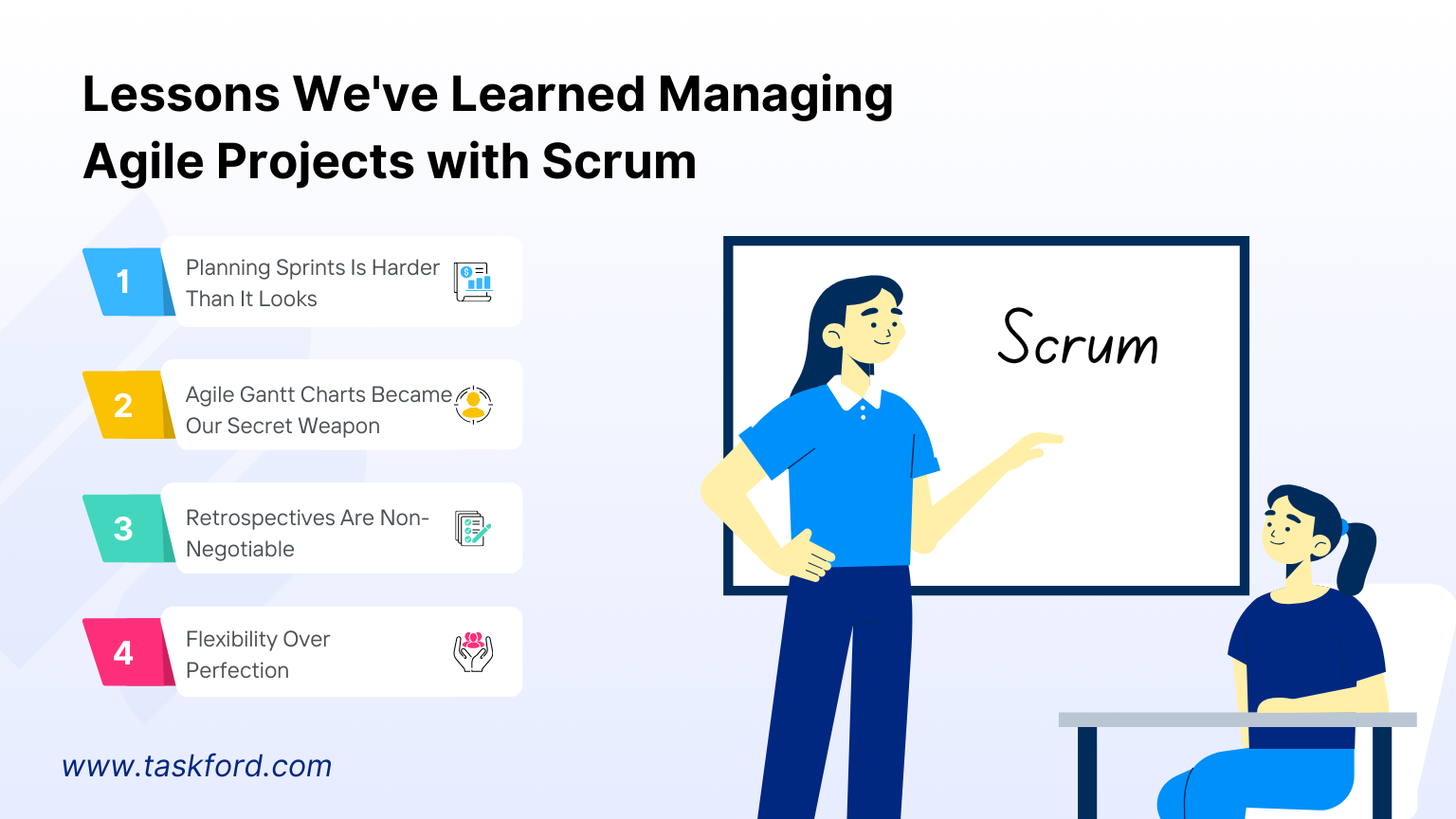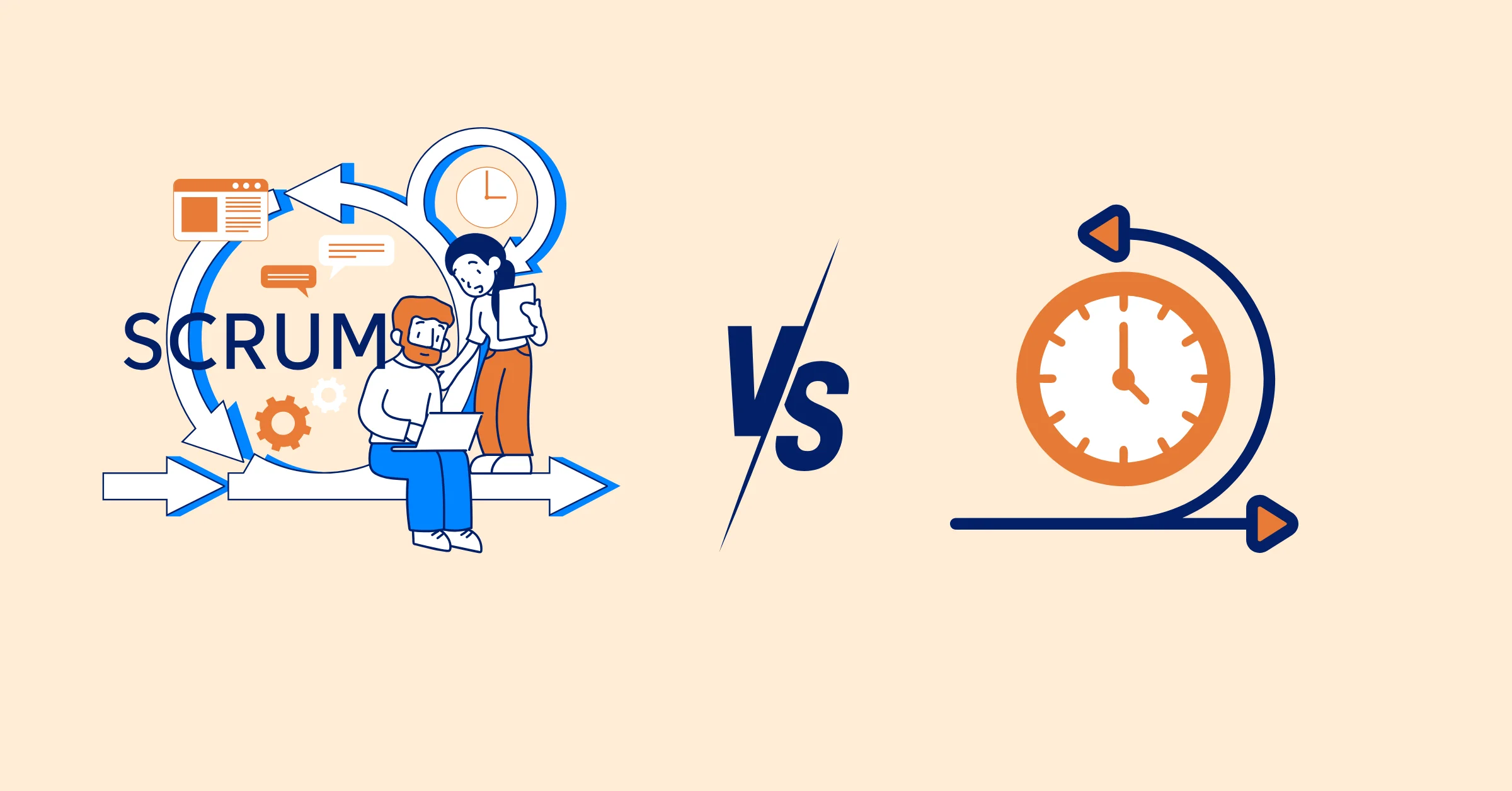Real-World Agile Project Management with Scrum: Lessons from the TaskFord Team
Discover how the TaskFord team applies Agile Project Management with Scrum in real-world projects. Learn practical tips, workflows, and mistakes to avoid based on true experiences.
Agile Project Management with Scrum has become one of the most effective ways to keep teams flexible, focused, and fast-moving in today’s dynamic work environment. By breaking projects into short, manageable sprints and encouraging continuous feedback, agile project management helps teams deliver high-quality results more efficiently than traditional methods.
At TaskFord, Agile isn't just theory — it's how we deliver real results. Here's what we've learned from applying Scrum principles in our day-to-day operations.
Why We Chose Agile Project Management with Scrum at TaskFord
Before adopting Agile Project Management with Scrum, our team at TaskFord experimented with several different project management approaches. For a time, we tried more traditional methods like the Waterfall model, where every phase of a project is completed in a strict, linear sequence.
While Waterfall gave us a clear structure, it also revealed serious limitations for our fast-paced startup environment. Requirements evolved mid-project, customer feedback came in earlier than expected, and by the time we finished a phase, some parts of the work were already outdated. It became clear that a rigid, step-by-step model simply couldn't keep up with the dynamic nature of building a SaaS product like TaskFord.
Scrum, as part of Agile Project Management, offered a better solution. The emphasis on short sprint cycles, frequent check-ins, and iterative delivery matched the way our teams naturally worked. Scrum allowed us to respond quickly to changes, continuously improve our process, and keep the entire team aligned without being trapped by long, inflexible timelines. It wasn't just a process shift, it became a mindset shift toward adaptability and customer-centric development.
Our Scrum Framework: How We Actually Apply It

At TaskFord, implementing Agile Project Management with Scrum meant more than just learning new terminology - it meant completely reshaping how we organized work across teams.
We operate using two-week Agile sprint cycles. Every sprint begins with a Sprint Planning meeting where our Product Owner outlines the top priorities based on customer feedback, internal goals, and technical needs. During planning, the team collectively decides which tasks they can realistically complete within the sprint window. We've learned that committing to less - but finishing everything - is far more valuable than overpromising.
Each morning, we hold a 15-minute Daily Standup where team members quickly share what they worked on yesterday, what they’re focusing on today, and if they’re facing any blockers. These check-ins keep everyone synchronized without dragging down productivity.
At the end of every sprint, we conduct a Sprint Review to demo completed work and gather feedback. Immediately following the review, we hold a Sprint Retrospective to reflect on what went well, what didn’t, and how we can improve in the next sprint.
We also adapted the classic Scrum roles to fit our team's structure:
-
Product Owner: Sets priorities and defines success for each sprint.
-
Scrum Master: Removes obstacles and facilitates the process.
-
Development Team: Cross-functional specialists responsible for delivering working product increments.
Instead of treating Scrum as a rigid checklist, we treat it like a flexible framework that helps us stay focused, collaborate better, and constantly evolve. That flexibility is critical for startups like ours, where speed, customer feedback, and innovation drive every project decision.
Lessons We've Learned Managing Agile Projects with Scrum
Transitioning to Agile Project Management with Scrum at TaskFord wasn’t always smooth. Along the way, we discovered that the real work isn’t just following the Scrum ceremonies, it's adapting them to your team's rhythm, strengths, and challenges. Here are a few hard-earned lessons from our journey.
1. Planning Sprints Is Harder Than It Looks
When we first started with Scrum, we seriously underestimated how much effort true sprint planning would require. We thought it was just a quick meeting to assign tasks. Instead, we quickly learned that good sprint planning demands a deep understanding of priorities, clear acceptance criteria, and realistic time estimates.
Our early sprints were packed with too much work, leading to half-finished tasks and frustrated developers. We turned things around by investing more time upfront: refining our backlog before Sprint Planning, involving developers early in effort estimation, and ruthlessly prioritizing work that aligned with sprint goals.
Now, sprint planning is one of our strongest rituals - a key factor in our delivery success.
2. Agile Gantt Charts Became Our Secret Weapon
At first, we avoided Gantt charts because "Scrum purists" warned against them. They said it would lock us into waterfall thinking. But honestly? Adding Agile Gantt Charts to our toolkit was a game-changer.
We use Gantt-style visualizations inside TaskFord to map out sprint timelines, dependencies, and major milestones without losing agility. Instead of rigidly locking dates, we treat the Gantt chart as a flexible visual guide - helping us spot risks early, balance workloads, and communicate sprint goals clearly across teams.
It’s proof that when adapted thoughtfully, traditional tools can empower Agile teams instead of restricting them.
3. Retrospectives Are Non-Negotiable
We learned quickly that skipping retrospectives - even when we're “too busy” - hurts the team more than it helps. Some of our biggest breakthroughs happened because we prioritized honest, structured retrospective sessions.
One memorable example: mid-2024, we realized during a retro that unclear sprint goals were leading to a lot of rework. As a team, we agreed to start each sprint with a simple "Definition of Done" checklist for every story. Within two sprints, our task completion rate jumped by 18%, and rework dropped sharply.
The key lesson? Retros aren't just nice-to-haves - they're essential for continuous improvement. And always, always document action items and follow up in the next sprint.
4. Flexibility Over Perfection
Early on, we obsessed over having the “perfect” sprint - perfect estimates, perfect velocity, perfect process adherence. Spoiler: we never found perfection.
What we found instead was a much more valuable mindset: embracing flexibility and iteration. Some sprints go better than others. Priorities shift. Bugs happen. Customer feedback changes direction.
At TaskFord, we learned to celebrate small wins, adapt mid-sprint when needed, and treat every cycle as a chance to get 1% better, not 100% perfect. That mindset shift has been crucial to sustaining high performance without burning out.

Key Takeaways for Teams Practicing Agile Project Management with Scrum
Building real-world experience with Agile Project Management with Scrum taught us that success isn't about following a textbook - it’s about adapting the framework to fit your team’s unique needs.
Here are the biggest lessons we’d share with any team starting (or struggling) with Scrum:
- Sprint Planning is critical: Invest the time to refine your backlog, involve your team in estimation, and set achievable goals.
- Gantt charts aren't the enemy: Use Agile Gantt Charts flexibly to visualize sprints, spot risks, and communicate better without sacrificing agility.
- Never skip retrospectives: Continuous improvement depends on honest reflection. Document action items and hold each other accountable.
- Flexibility beats perfection: Agile is about responding to change, not sticking rigidly to a plan. Focus on iteration, not flawless execution.
- Scrum is a guide, not a cage: Adapt ceremonies, roles, and artifacts to what serves your team best — don't be afraid to make Scrum work for you.
The beauty of Agile Project Management with Scrum is that it gives teams a foundation for collaboration, learning, and delivering real value - even when the path isn’t perfectly straight.
If you're new to Project Management and want to start from the ground up, check out our Project Management 101 - a comprehensive guide for a deeper dive into essential principles and strategies.
Conclusion
Adopting Agile Project Management with Scrum at TaskFord has been an evolution — one that’s allowed us to be more flexible, deliver faster, and continuously improve. While the process hasn’t always been smooth, the lessons we’ve learned have been invaluable in helping us build better products and stronger teams.
Scrum isn’t just a framework; it’s a mindset that drives us to embrace change, focus on customer feedback, and always look for ways to improve. If there’s one thing we’ve learned, it’s that Agile isn’t about perfection - it’s about progress.
Ready to see how Scrum can transform your team’s workflow? Discover TaskFord’s Project Management Features and start managing your projects with real-time collaboration, flexibility, and power that only Agile can provide!
Making work simpler,
smarter, and more connected
Join our waitlist and be notified first.

Related Blog
Subscribe for Expert Tips
Unlock expert insights and stay ahead with TaskFord. Sign up now to receive valuable tips, strategies, and updates directly in your inbox.






